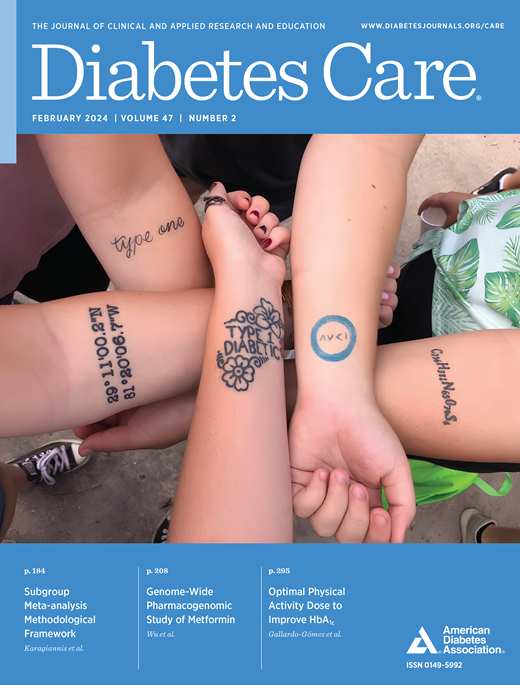Prescribing Trends of Antidiabetes Medications Near End-of-Life Among Adults With Type 2 Diabetes: A Cohort Study
IF 14.8
1区 医学
Q1 ENDOCRINOLOGY & METABOLISM
引用次数: 0
Abstract
OBJECTIVE To assess prescribing trends of antidiabetes medications in the last year of life among older adults with type 2 diabetes (T2D) and explore whether frailty is associated with differential prescribing. RESEARCH DESIGN AND METHODS In this observational cohort study of Medicare beneficiaries aged ≥67 years (2015–2019) with T2D, we assessed temporal trends in prescribing an antidiabetes medication, stratified by frailty. The main outcome included antidiabetes medication fills within 1 year of death. RESULTS Among 975,407 community-dwelling Medicare beneficiaries with T2D, the use of antidiabetes medications within 1 year of death slightly increased from 71.4% during the first 6-month period in 2015 to 72.9% (standardized mean difference [SMD] −0.03) during the second 6-month period in 2019. The most pronounced increase in use was observed for metformin (40.7% to 46.5%, SMD −0.12), whereas the largest decrease was observed for sulfonylureas (37.0% to 31.8%, SMD 0.11). Overall antidiabetes medication use decreased from 66.1% in the 9 to 12 months before death to 60.8% in the last 4 months of life (SMD 0.11; P < 0.01), driven by reduced noninsulin medication use. The use of short-acting and long-acting insulin both increased near death, with frailer individuals more likely to receive insulin. Sodium–glucose cotransporter-2 inhibitors and glucagon-like peptide 1 receptor agonists, although less common, became more frequent in more recent years. CONCLUSIONS The use of antidiabetes medications declined in the last year of life, mainly due to reduced noninsulin use. Insulin use increased near death, particularly among frailer individuals, highlighting the need for careful end-of-life management.2型糖尿病患者临终前抗糖尿病药物的处方趋势:一项队列研究
目的评估老年2型糖尿病(T2D)患者生命最后一年抗糖尿病药物的处方趋势,并探讨身体虚弱是否与差异处方有关。研究设计与方法在这项针对年龄≥67岁(2015-2019)的T2D医疗保险受益人的观察性队列研究中,我们评估了处方抗糖尿病药物的时间趋势,并按虚弱程度分层。主要结局包括死亡1年内的抗糖尿病药物填充。结果:975,407名T2D社区医疗保险受益人中,死亡后1年内使用抗糖尿病药物的比例从2015年的前6个月的71.4%小幅上升至2019年的后6个月的72.9%(标准化平均差[SMD] - 0.03)。二甲双胍的使用增加最为明显(40.7%至46.5%,SMD为- 0.12),而磺脲类药物的使用减少幅度最大(37.0%至31.8%,SMD为0.11)。总体抗糖尿病药物使用率从死亡前9至12个月的66.1%下降到生命最后4个月的60.8% (SMD 0.11;P, lt;0.01),这是由于非胰岛素类药物使用减少所致。短效和长效胰岛素的使用都增加了接近死亡的几率,身体虚弱的人更有可能接受胰岛素治疗。钠-葡萄糖共转运蛋白2抑制剂和胰高血糖素样肽1受体激动剂虽然不常见,但近年来越来越常见。结论抗糖尿病药物的使用在生命的最后一年有所下降,主要是由于非胰岛素使用的减少。胰岛素的使用在接近死亡时增加,特别是在身体虚弱的个体中,这突出了对临终管理的需要。
本文章由计算机程序翻译,如有差异,请以英文原文为准。
求助全文
约1分钟内获得全文
求助全文
来源期刊

Diabetes Care
医学-内分泌学与代谢
CiteScore
27.80
自引率
4.90%
发文量
449
审稿时长
1 months
期刊介绍:
The journal's overarching mission can be captured by the simple word "Care," reflecting its commitment to enhancing patient well-being. Diabetes Care aims to support better patient care by addressing the comprehensive needs of healthcare professionals dedicated to managing diabetes.
Diabetes Care serves as a valuable resource for healthcare practitioners, aiming to advance knowledge, foster research, and improve diabetes management. The journal publishes original research across various categories, including Clinical Care, Education, Nutrition, Psychosocial Research, Epidemiology, Health Services Research, Emerging Treatments and Technologies, Pathophysiology, Complications, and Cardiovascular and Metabolic Risk. Additionally, Diabetes Care features ADA statements, consensus reports, review articles, letters to the editor, and health/medical news, appealing to a diverse audience of physicians, researchers, psychologists, educators, and other healthcare professionals.
 求助内容:
求助内容: 应助结果提醒方式:
应助结果提醒方式:


